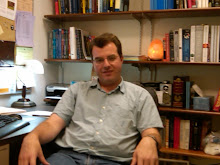Most of the k-12 "reforms" that set Hofstadter on fire with rage apparently came into vogue after WWI. There were certain fads and experiments in k-12 in the 19th century, but high school attendance was far from universal. In the early 20th century, especially right after the Progressive Era, high school attendance became much more common place. Once that happened, the experimentation started. Fads, anti-intellectualism, and democratic sentiment in education spring from American cultural strains of colonial pedigree (if not older), but they did not really come into their own until a bureaucracy had to spring up to cater to the masses. Intellectualism is, almost by definition, not scalable to mass production. I can hold forth on the weird psychology of faculty, the incentives of the educational software vendors, and the cultural legacy of the Great Awakening until I go blue in the face, but the full energies of reformist zeal will only be unleashed against us academics when there's a call to cater to the masses. God help us if graduate education is ever targeted for some good, hard "democratization."
Anyway, on to the blistering:
Page 335, in response to a 1918 NEA commission report on restructuring high school, Hofstadter summarizes their recommendations with:
In short, the inner structure of various disciplines was to be demoted as an educational criterion and supplanted by greater deference to the laws of learning, then presumably being discovered.Page 340:
There is an element of moral overstrain and curious lack of humor among American educationists which will perhaps always remain a mystery to those more worldly minds that are locked out of their mental universe. The more humdrum the task the educationists have to undertake, the nobler and more exalted their music grows. When they see a chance to introduce a new course in family living or home economics, they begin to tune the fiddles of their idealism. When they feel they are about to establish the school janitor's right to be treated with respect, they grow starry-eyed and increase their tempo. And when they are trying to assure that the location of the school toilets will be so clearly marked that the dullest child can find them, they grow dizzy with exaltation and launch into wild cadenzas about democracy and self-realization.
The silly season in educational writing had now opened. The professionalization of education put a premium upon the sober treatment of every mundane problem, and the educators began to indulge in solemn and pathetic parodies of the pedantry of academic scholarship. Not liking to think of themselves as mere advocates of low-grade utilities, they began to develop the art of clothing every proposal, no matter how simple, common-sense, and sound, in the raiments of the most noble social or educational objectives.Page 345, in response to a high school curricular movement called "life adjustment" (which apparently peaked in the 1950's):
Life-adjustment educators would do anything in the name of science except encourage children to study it.Page 349:
As W.C. Bagley once remarked: "It was inevitable that any theory which justified or rationalized the loosening of standards should be received with favor," by those who, without deliberate intent, distorted experimental findings in the interest of their mission to reorganize the high schools to accommodate the masses.Page 353:
The life-adjustment movement would establish once and for all the idea that the slow learner is "in no sense" the inferior of the gifted, and the principle that all curricular subjects, like all children, are equal.It should go without saying, of course, that today's educational fashions are completely different and nowhere near as silly, and they will certainly not fall out of favor with the passage of time.



No comments:
Post a Comment